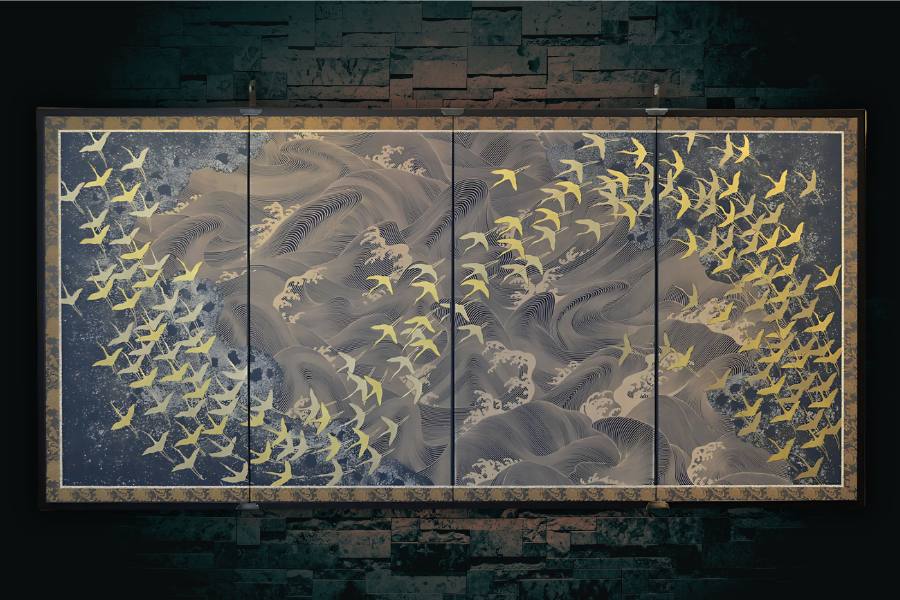Introduction: Encountering a Byobu
Byobu Folding Screen with 4 Panels "Flying Cranes"
As the soft autumn light fills your room in September, placing a Japanese folding screen (Byobu) in a corner can transform the atmosphere in an instant. Unlike walls or furniture, a Byobu introduces a subtle boundary and brings a sense of calm and elegance to the space. For over a thousand years, Japanese folding screens have been cherished for their ability to shape a room, organize the mind, and reflect beauty.
History: From Functional Screens to Artistic Masterpieces
The origin of Byobu traces back to China, but it was introduced to Japan during the Nara period as a practical tool for blocking drafts. Literally meaning "wind-blocking wall," Byobu initially served to shield sleeping areas and hallways from cold air. Over time, Japan’s unique climate, architectural styles, and aesthetic sensibilities transformed it from a practical item into a work of art.

During the Heian period, Japanese folding screens evolved into decorative elements in aristocratic homes. Screens often depicted seasonal landscapes, poems, and classic stories, adding elegance and sophistication to interiors. Beyond visual beauty, they served as a reflection of cultural refinement and education.
In the Muromachi and Momoyama periods, Byobu became prevalent in the residences of samurai and tea masters. Lavishly adorned with gold and silver leaf, these screens symbolized authority and status. The connection with tea culture made Byobu an essential tool for arranging space in tea rooms and reception areas.
By the Edo period, the popularity of folding screens spread to common households. They became essential for weddings, seasonal festivals, and home decoration. Gold-leaf screens featuring birds, flowers, and auspicious symbols not only beautified homes but also brought a sense of fortune and well-being. From a practical tool to a cultural icon, Japanese folding screens became a way to enrich everyday life with art and symbolism.
The Craftsmanship Behind a Byobu

Creating a Byobu is a meticulous process of Japanese craftsmanship. Entering a workshop, one is greeted by the scent of cedar and rows of carefully planed wooden frames. Craftsmen join the wood precisely without nails or metal fasteners, using gentle taps with a wooden mallet. The "hane" or paper hinges allow smooth folding and unfolding, essential for usability.
Multiple layers of thin Japanese paper, known as the "underlayer," give the screen strength and flexibility, creating a surface that seems to breathe. Finally, the top layer—artistic paper or fabric featuring paintings or calligraphy—is applied. Fabric trims and decorative fittings complete the screen, giving it a dignified presence. This process encapsulates the essence of handmade Japanese screens in every detail.
Byobu Structure: Panels, Pairs, and Sections

Each Japanese folding screen consists of multiple panels, and a single panel is called a "sen" (扇). Panels are counted from right to left, with the rightmost being the first panel, the next to the left the second panel, and so on. The total number of panels determines the screen's form, such as two-panel (二曲, ni-kyoku), four-panel (四曲, yon-kyoku), or six-panel (六曲, roku-kyoku) screens.
Screens can also be paired. A set of two screens forms a "sou" (双), while a single unpaired screen is called a "seki" (隻). For example, a six-panel screen paired as a set is called a roku-kyoku issou (六曲一双). Within a pair, the right screen is called the useki (右隻), and the left screen is the saseki (左隻). Understanding these terms helps appreciate both the structure and aesthetic rhythm of traditional Byobu.
Byobu and Daily Life in Japan

Byobu have long been an integral part of Japanese living. In the Nara and Heian periods, they were used as makura-byobu near sleeping areas to block cold drafts and as room dividers. Aristocrats would enjoy the imagery of seasonal landscapes or storytelling scenes on the screens while reading or composing poetry, making the Byobu not just practical, but a source of mental and visual comfort.
During the Edo period, Byobu became part of weddings, seasonal celebrations, and festival décor. Sitting in front of a folding screen created an air of ceremony, while the motifs of pine, bamboo, plum, and seasonal flowers symbolized good fortune. Even in ordinary households, folding screens allowed people to celebrate seasonal changes and special occasions with a sense of grace and meaning.
Beyond their decorative and symbolic role, Japanese folding screens also influenced the atmosphere of interior spaces. In reception rooms or tea rooms, Byobu would interact with light and shadow, subtly changing throughout the day and enhancing the perception of space. They exemplify Japan’s unique approach to interior design, where practicality and art coexist harmoniously.
Modern Interiors and Japanese Folding Screens
Even today, Japanese folding screens remain versatile interior design elements. They complement traditional tatami rooms and blend seamlessly into Western-style bedrooms and living rooms. Placed near a bed, a screen adds softness and sophistication, while smaller screens can be displayed on chests or along walls, adding depth and dimension. Both traditional gold-leaf Byobu and contemporary designs offer seasonal charm and elegance.
Byobu Folding Screen with 4 Panels "Cherry blossoms"
"Simply placing a Byobu in your bedroom transforms an everyday space into a serene and elegant sanctuary."
Byobu from the Kyoto Handicraft Center
At our Kyoto Handicraft Center, each screen is handcrafted using traditional techniques. Compact two-panel and four-panel Byobu fit beautifully in living rooms or bedrooms, and seasonal variations in design allow for rotating décor throughout the year. Gold-painted screens provide a refined focal point, akin to displaying a work of art. These handmade Japanese screens not only beautify your home but also bring a sense of harmony and time-honored craftsmanship to any space.
Byobu, a Crystal of Time
Byobu are timeless "crystals of time," preserving centuries of Japanese craftsmanship while enriching modern living. Standing a folding screen in the soft autumn light, one feels its quiet message:
"Cherish the time that resides here."



